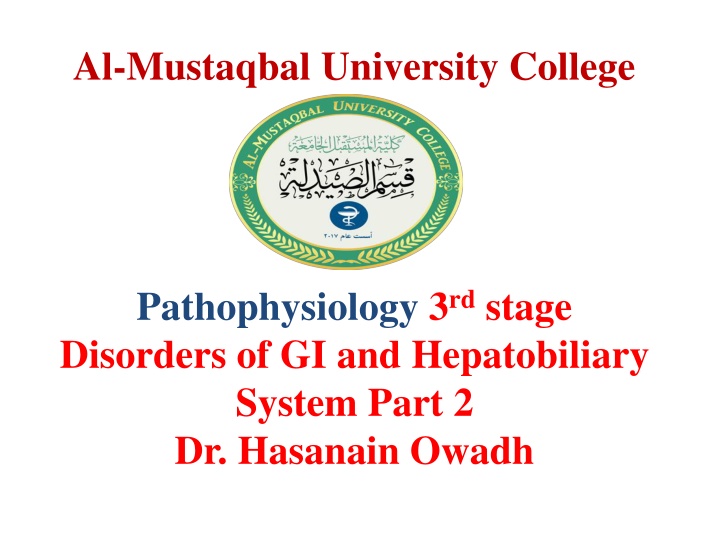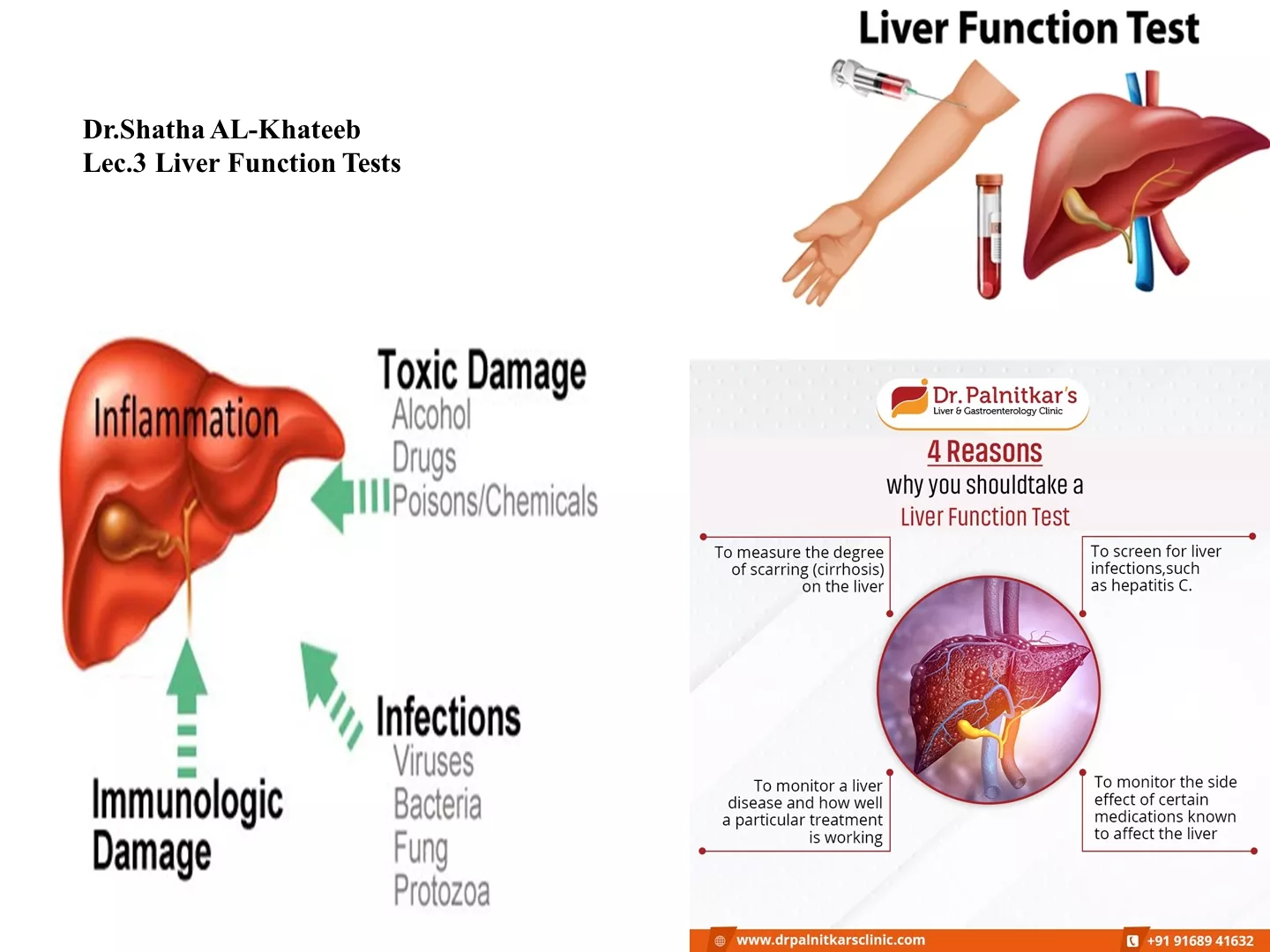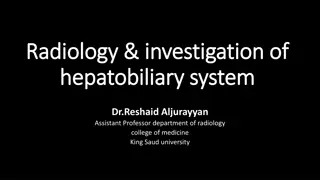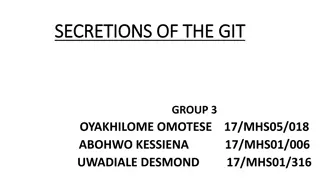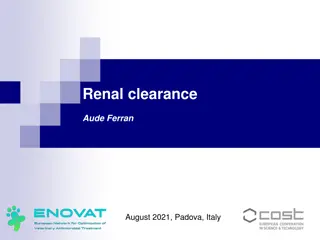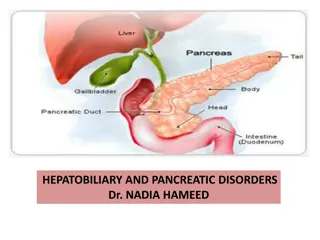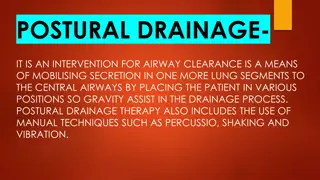Disorders of GI and Hepatobiliary System: Hunger, Mucus Secretion, Bile Circulation, Waste Elimination, Liver Functions
The content delves into the pathophysiology of gastrointestinal and hepatobiliary disorders, covering topics like hunger control, mucus secretion, enterohepatic circulation of bile, waste elimination, and the critical functions of the liver in metabolic, absorptive, and immunologic processes.
Download Presentation

Please find below an Image/Link to download the presentation.
The content on the website is provided AS IS for your information and personal use only. It may not be sold, licensed, or shared on other websites without obtaining consent from the author.If you encounter any issues during the download, it is possible that the publisher has removed the file from their server.
You are allowed to download the files provided on this website for personal or commercial use, subject to the condition that they are used lawfully. All files are the property of their respective owners.
The content on the website is provided AS IS for your information and personal use only. It may not be sold, licensed, or shared on other websites without obtaining consent from the author.
E N D
Presentation Transcript
Al-Mustaqbal University College Pathophysiology 3rdstage Disorders of GI and Hepatobiliary System Part 2 Dr. Hasanain Owadh
Hunger and the Ingestion of Food Hunger is controlled by an area of the brain in the lateral hypothalamus. Stimulation of this area causes a strong desire to seek out and to eat food. Secretion of Mucus Mucus is secreted by gut. It serves to protect gut wall from being digested by the enzymes to which it is exposed. It also serves to lubricate food, allowing for easier passage.
Enterohepatic Circulation of Bile After the bile salts deliver fatty acids and monoglycerides to the villi. Most of the remaining bile salts are eventually reabsorbed at the end of the small intestine and are recycled back to the liver via the portal vein to be used again. This process is called enterohepatic circulation.
Elimination of Waste Products Only 100 mL of fluid and virtually no electrolytes are excreted. Besides water, which makes up approximately 75% of feces, feces contain dead bacteria, some undigested fat and roughage, and a small amount of protein. Bilirubin byproducts give the feces its color.
Accessory Organs of Digestion The liver produces bile (through the sphincter of Oddi), which contains salts necessary for fat digestion and absorption. Between meals, bile is stored in the gallbladder. The exocrine pancreas produces: (1)enzymes needed for the complete digestion of carbohydrates, proteins, and fats; and (2) an alkaline fluid that neutralizes chyme, creating a duodenal pH that supports
The liver weighs 1200 to 1600 g. Most liver blood flow, approximately 1000 mL/min, is venous blood draining from the stomach, the small and large intestines, the pancreas, and the spleen.
Functions of the Liver Type Metabolic Absorptive Period Function Converts glucose to glycogen and triglycerides; stores glycogen. Converts amino acids to fatty acids or stores amino acids. Makes lipoprotein from triglycerides and cholesterol. Postabsorptive Period Produces glucose from glycogen (glycogenolysis) and fatty acids and amino acids (glyconogenesis). Converts fats to ketones (accelerated if fasting). Produces urea from protein catabolism. Immunologic Metabolic Transformation Macrophages filter blood. Detoxifies or conjugates waste products, hormones, drugs. Clotting Functions Produces several essential clotting factors. Plasma Proteins Exocrine Functions Synthesizes albumin and other plasma proteins. Synthesizes bile salts. Endocrine Functions Involved in activation of vitamin D. Produces angiotensinogen. Secretes insulin-like growth factors (somatomedin).
Secretion of Bile The liver assists intestinal digestion by secreting 700 to 1200 ml of bile per day. Bile is an alkaline, bitter-tasting, yellowish green fluid that contains bile salts (conjugated bile acids), cholesterol, bilirubin (a pigment), electrolytes, and water.
Alcohol Handling by the Liver The hepatocyte metabolises Alcohol by two pathway alcohol dehydrogenase and secondly by microsomal ethanol oxidizing system (MEOS), those result in the end-product of acetaldehyde. The free radicals and the acetaldehyde produced by either metabolic pathway are highly damaging to liver cells.
Tests of liver function are frequently performed. Measurement of total bilirubin, as well as separate levels of conjugated and unconjugated bilirubin. Measurement of liver enzymes, including serum glutamic pyruvic transaminase (SGPT), serum glutamic oxaloacetic transaminase (SGOT), and alkaline phosphatase. Measurement of plasma protein concentration. Level of all previous increase with liver disease. Measurement of prothrombin time (a test of coagulation). Because coagulation depends on adequate liver production of coagulation factors, prothrombin time increases with liver disease. Ultrasound, computed tomography (CT) scan, and magnetic resonance imaging (MRI) can indicate structural defects or stones in the bile duct or gallbladder. Liver biopsy allows tissues to be observed directly for confirmation of infection, fatty infiltration or fibrosis, and cancer.
Cirrhosis: Cirrhosis is an irreversible inflammatory, fibrotic liver disease Diffuse liver scarring and fibrosis characterize cirrhosis. Hard fibrous nodules replace normal liver tissue, and constrictive, fibrous bands encircle the hepatocytes. Cirrhosis occurs in the liver in response to repeated incidents of cellular injury and the resultant inflammatory reactions.
Causes of cirrhosis include: - Infections such as hepatitis. - Bile duct obstruction. - Alcohol.
Alcoholic Cirrhosis Alcoholic cirrhosis occurs after years of alcohol abuse. That by end-products of alcohol digestion, especially oxygen free radicals, which are toxic to hepatocytes. Alcoholic cirrhosis has three stages: 1- Fatty liver disease, It is a reversible condition characterized by triglyceride accumulation in the hepatocytes.
2- alcoholic hepatitis Hepatitis is the inflammation of liver cells. Inflammation and subsequent necrosis of some cells usually occurs after a serious increase in alcohol intake in long-term alcohol abusers. 3- Cirrhosis itself is the final, irreversible stage of alcoholic cirrhosis. In this stage, dead liver cells are replaced by scar tissue.
Clinical Manifestations hepatomegaly. vague abdominal discomfort, anorexia, and nausea may occur. Fatigue is common. Edema, ascites, and jaundice begin. With advanced cirrhosis, manifestations of liver failure may appear.
Diagnostic Tools Elevated bilirubin levels are present. Prolonged prothrombin time resulting from decreased coagulation factors. Liver biopsy can confirm cirrhosis. Complicatons Liver failure, leading to transplantation or death, may develop.
Hepatitis Hepatitis is the inflammation of the liver. It can be caused by an infection or by toxins, including alcohol, and is seen with hepatic cancer. Signs and symptoms for each type of hepatitis are similar. Modes of transmission and eventual outcomes may be different.
Viral Hepatitis The viruses that cause hepatitis lead to hepatocyte injury primarily by stimulating host inflammatory and immune reactions that secondarily damage the hepatocytes; or viruses may directly injure the cells as well. Hepatitis A It is primarily passed by oral-fecal contamination resulting from poor hygiene or contaminated food. The time between exposure and onset of symptoms (incubation period) for HAV is between 4 and 6 weeks.
Hepatitis B Hepatitis B (HBV) is a serious disease throughout the world. HBV has a long incubation period, between 1 and 7 months. Approximately 5 to 10% of adults with HBV develop chronic hepatitis and continue to experience hepatic inflammation for longer than 6 months. Chronic hepatitis may be slowly progressive or may be fulminant, leading to hepatic necrosis, cirrhosis, liver failure, and death.
Hepatitis C Hepatitis C (HCV) was identified in 1989. The incubation period for HCV ranges from 15 to 150 days. Symptoms tend to be milder than for HBV, individuals may not recognize they have a serious infection and thus may not seek health care or be diagnosed. Unlike hepatitis B, hepatitis C seldom leads to fulminating hepatitis.
Hepatitis D (HDV) is called the delta hepatitis agent and is a defective virus that cannot on its own infect the hepatocyte to cause hepatitis. Instead, it co-infects with HBV, leading to a worsening of the HBV infection. Hepatitis E (HEV) It is an RNA virus primarily transmitted by ingestion of contaminated water and has symptoms like HAV infection. It neither results in a carrier state nor causes chronic hepatitis.
Clinical Manifestations There are three stages of illness for all types of hepatitis: 1- The prodromal stage, 2- The icterus (jaundice) stage, and 3- The convalescent (recovery) period. The prodromal stage, called the preicterus period, Antibodies to the virus are not usually present. This stage lasts 1 to 2 weeks. It is characterized by: General malaise Fatigue Symptoms of upper respiratory tract infection Myalgia (muscle pain)
The icterus or jaundice stage: it may last 2 to 3 weeks or much longer. It is characterized by Jaundice Worsening of all symptoms present during the prodromal stage Hepatic tenderness and enlargement Splenomegaly Possible itchiness (pruritus) of the skin
3- The recovery stage is the third stage of viral hepatitis and usually happens within 4 months for HBV and HCV and within 2 to 3 months for HAV. During this period: Symptoms subside, including jaundice. Appetite returns.
Diagnostic Tools Liver enzymes are abnormal. Antibodies to the virus are elevated, starting in the icterus stage. Viral antigen is detectable in blood of individuals. Complications Chronic hepatitis cirrhosis, hepatocellular carcinoma, and death.
Thank you
